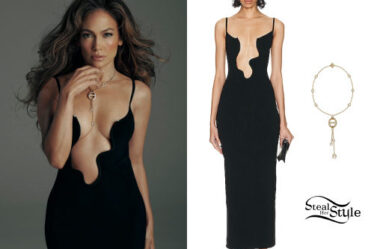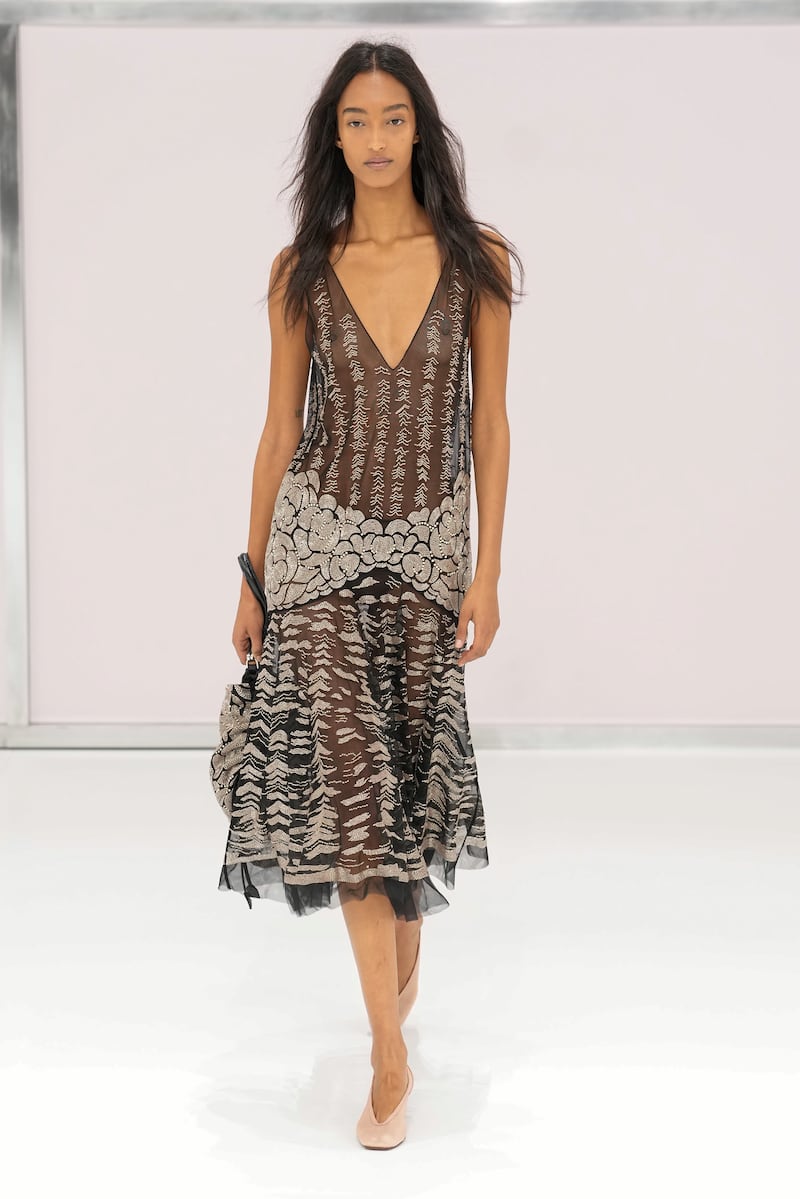
MILAN — With Fendi providing so much grist for the fashion rumour mill over the past few months, you would hardly blame Kim Jones for feeling less than celebratory about the brand’s centennial in 2025. But prince of pragmatism that he is, there can never be too much on his plate to deal with, so he blocked out the noise and came up with one of his best interpretations of Fendi yet. My favourite Fendi collections over the years have always had something cinematic about them, and that was the way this one played out, like a family saga flashing backward and forward between decades (I’m loving “Pachinko” on Apple TV+ for the same reason), from Adele starting her business in 1925 to her great-granddaughter Delfina creating the jewellery that has accessorised the collection since Jones took over as artistic director in 2020.
He calls Fendi his second family, and that affection showed in odd sentimental, even domestic, details: embroidered stockings that bagged round the ankles, dresses that looked like slips donned upside down, light-as-air housecoats. Even the grand finale, where the huge box at centre stage opened to reveal the models posed in a tableau vivant, was, Jones said, inspired by department store windows “where we loved clothes in the first place.” The footwear was a collaboration with Red Wing, a brand which is 20 years older than Fendi. When legacies collide, they make a shoe which a lot of people are going to want next year, especially with the signature Selleria stitching. Speaking of leather goods, there were noticeably a lot of bags in the show, good news for a brand whose arm candy is an industry standard. One dangly bag ornament looked like a jar of jam, which made it a perfect complement to the new enlarged Baguette. Next season, a butter dish bag?
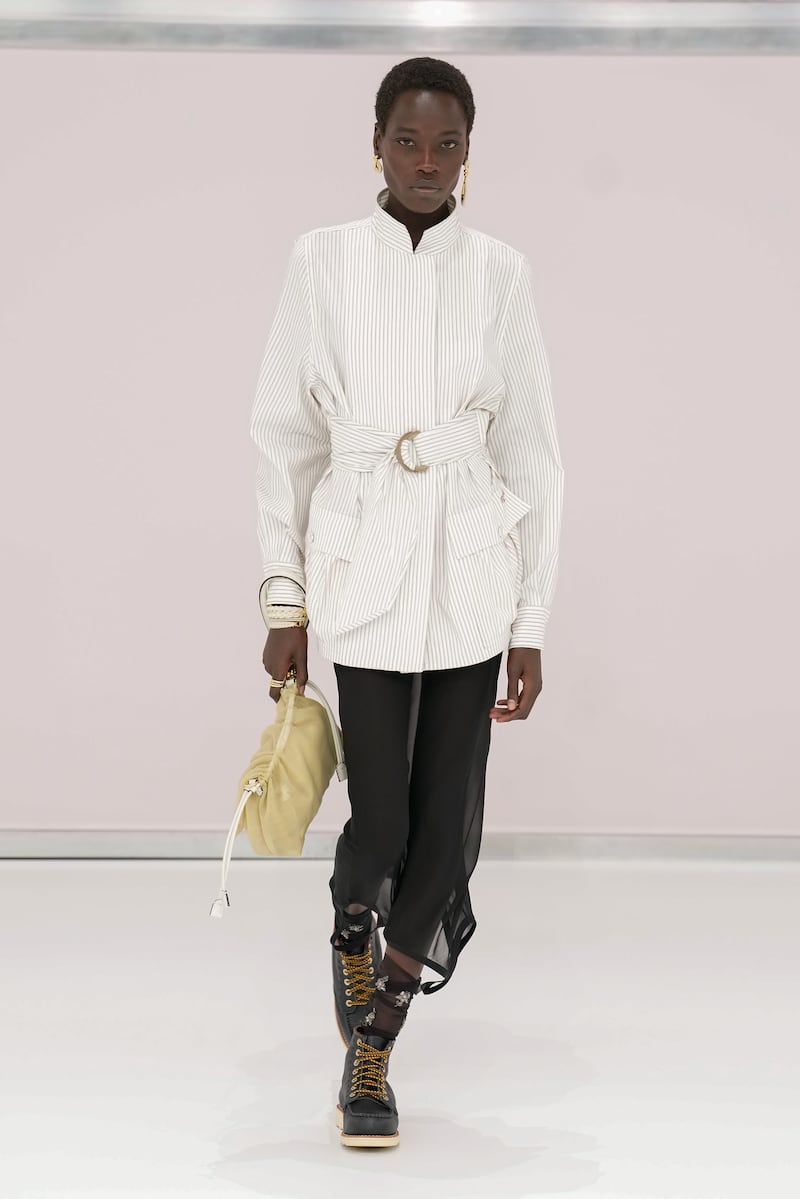
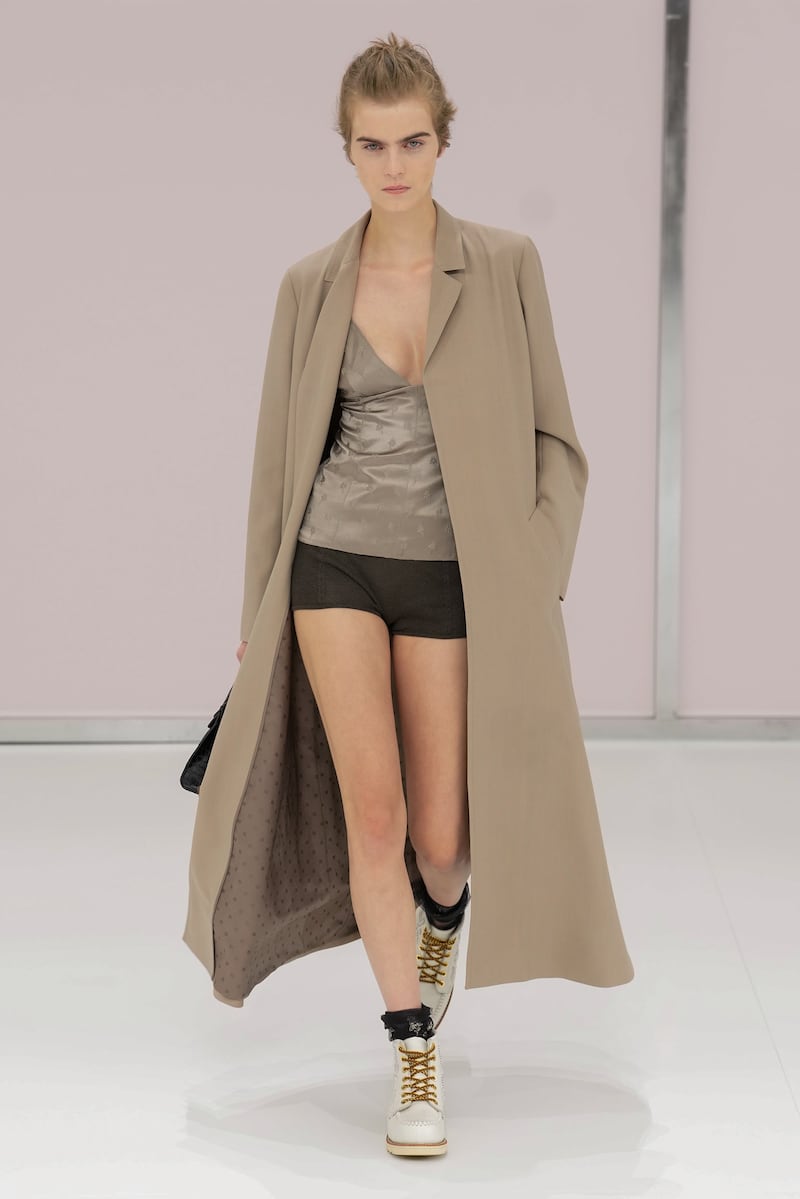
But it was the varied airiness of the show that really struck, after seasons of occasionally heavy-ish bourgeois-with-a-twist dressing inspired by Delfina’s personal style. Here, there were filmy gilded shifts and dropped waists that evoked Art Deco elegance (Adele’s era), tea dresses and shirt dresses that had a breezy 50s functionality (maybe that would be her daughter Anna, one of the Formidable Fendi Sisters), cool cotton shirts in a banker’s stripe, worn oversize and belted with the authority of Anna’s equally formidable daughter Silvia, and finally, Delfina … a tank and knickers under a duster, perhaps. “Looking forward and back,” according to Jones. He was keen to show off the technical skills of the famous Fendi atelier when they weren’t doing fur. “We don’t want to talk about fur,” he added. That was another challenge he appears to have met and mastered head on. Next, those pesky rumours…
Alice in Wonderland’s White Rabbit is Francesco Risso’s spirit animal, but he had another creature in mind at his Marni show on Tuesday. Scrawled in felt tip across his t-shirt was the name Léon, he of Luc Besson’s 1994 revenge thriller. It was the kind of free-associative leap Risso excels at. “Léon is a brutal killer but he becomes very protective of a child,” he explained. “I feel like this collection is my child.” And it too needs protecting in a global moment he described as “inhuman and cruel.”
“I don’t think we’re going to save the world with this,” Risso added. “But in our little landscape, it’s necessary that we focus on beautiful things, and to make beauty. This is in our power, it’s our mission.”
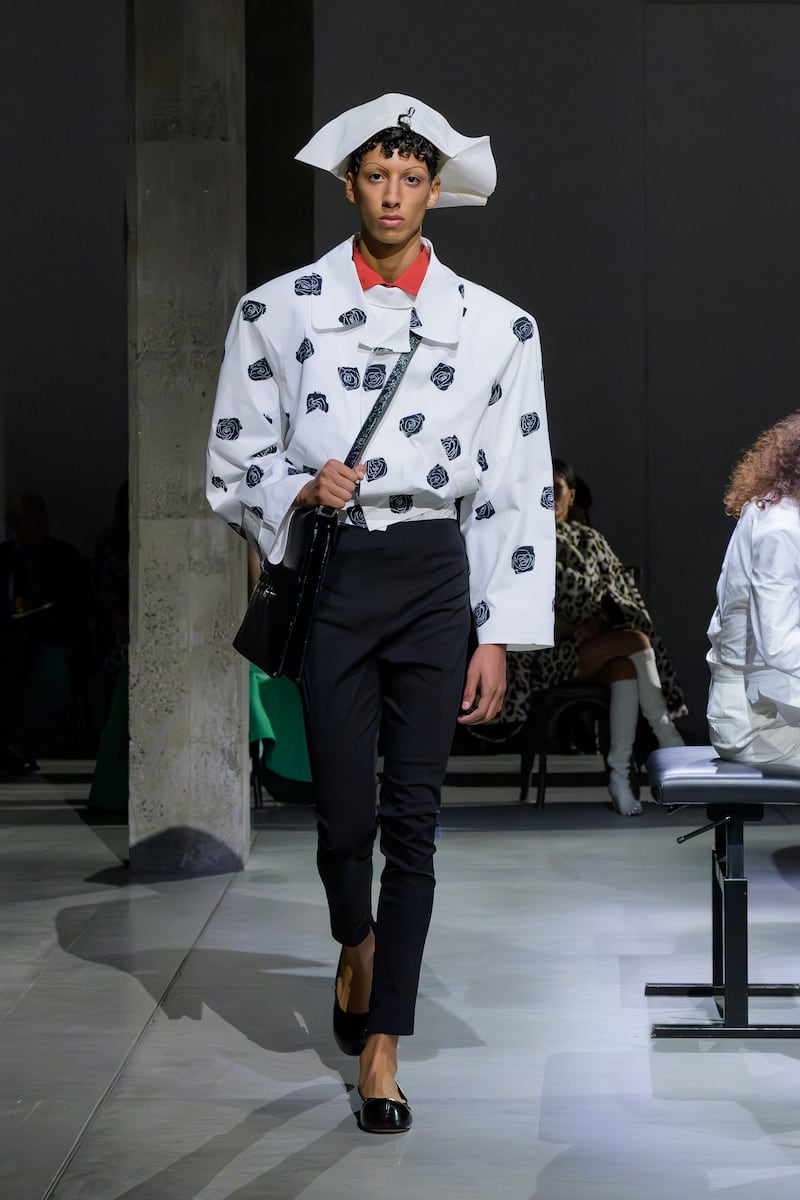
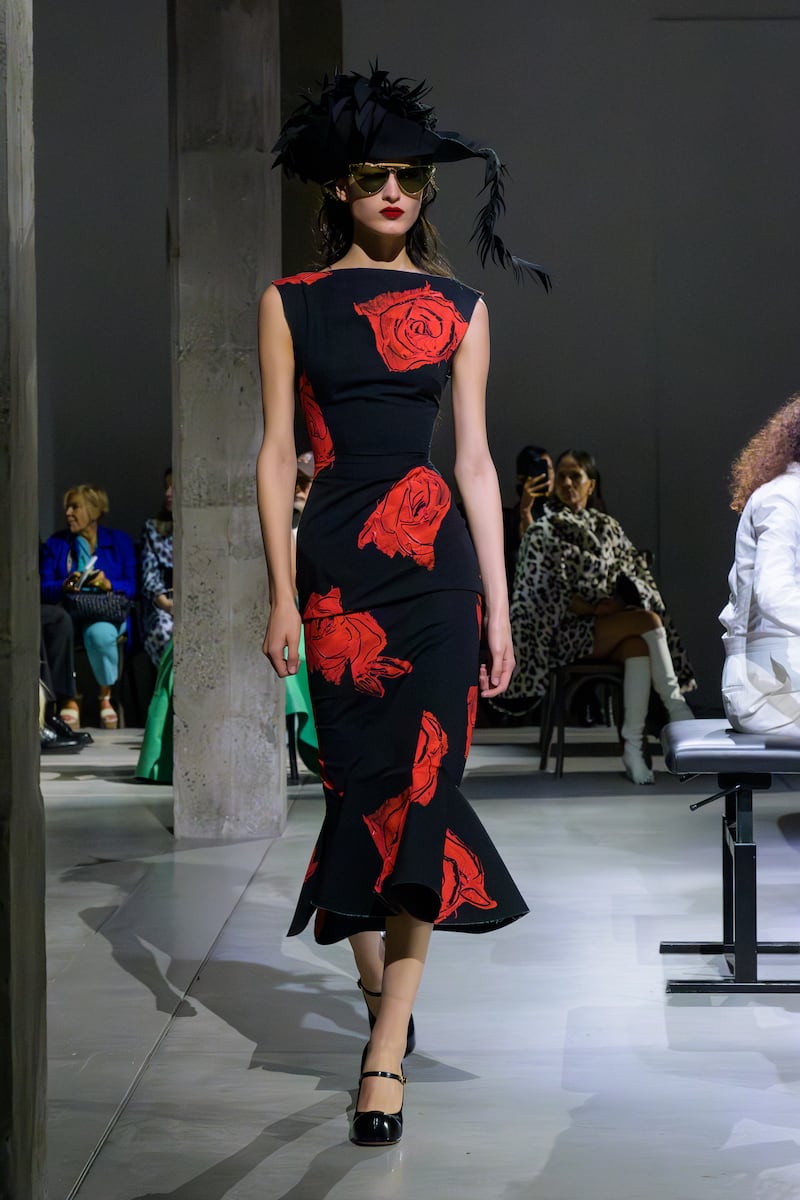
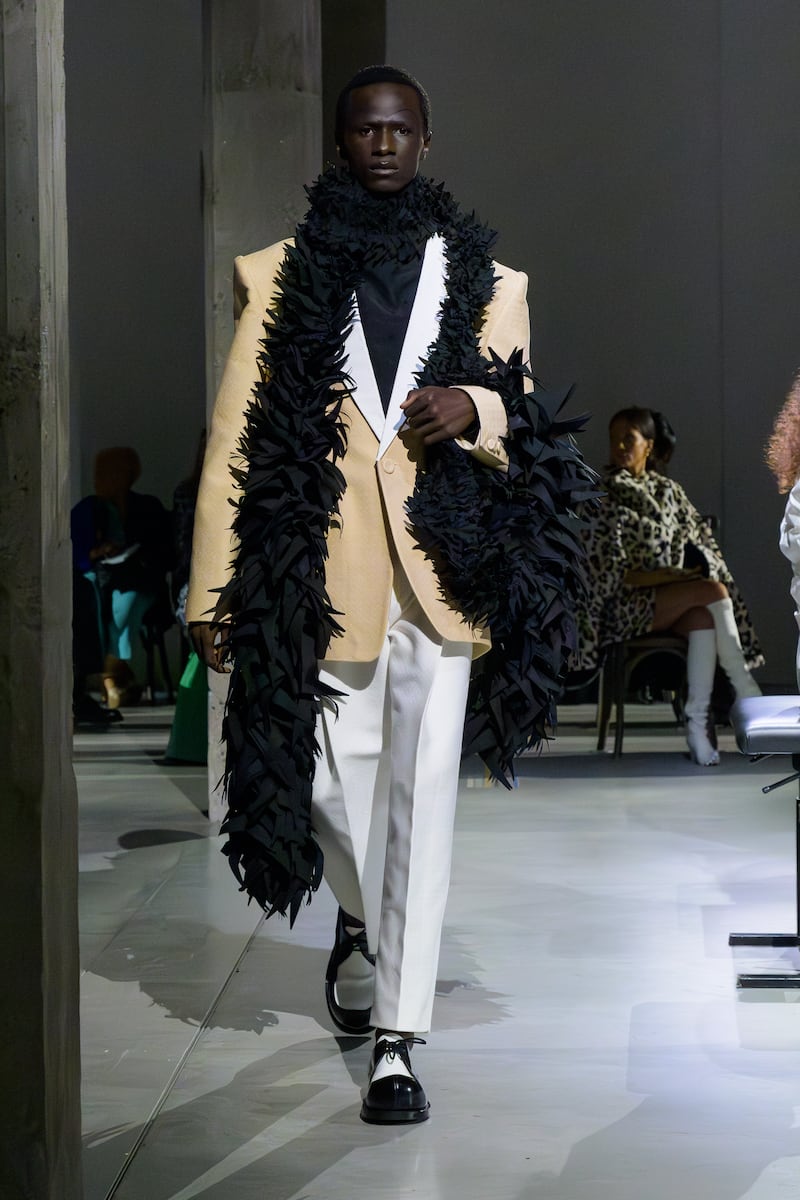
For Risso, beauty is an elemental thing. “Marni means ‘of the sea’, like a wave,” he pointed out. But there’s also something paradoxical in his pitch, a hyper-sophistication that is tempered by an attraction to the raw, the unfinished. Risso has staged his shows in some pretty unruly environments (last season’s paper catacombs!) though he also claims he’s partial to extravagance. This season, the setting was more decorous. Café chairs were scrupulously arranged in the show space so that everyone was kind of sitting on their own, and models manoeuvred around them as a trio of musicians led by longtime Risso collaborator Dev Hynes pounded on grand pianos in a steadily mounting crescendo of sound. Extravagantly physical, extravagantly emotional.
Risso called the show the Essential Beauty Routine, by which he meant a linear narrative where his collection progressed from morning through afternoon to evening, with sizing starting plain, simple and small, close to the body, and then getting progressively bigger in scale and dressier, before climaxing in an orgy of rococo beading and frond-y decoration. Remarkably, almost everything was made of cotton, “the most resistant material that we have invented in time,” Risso said cryptically.
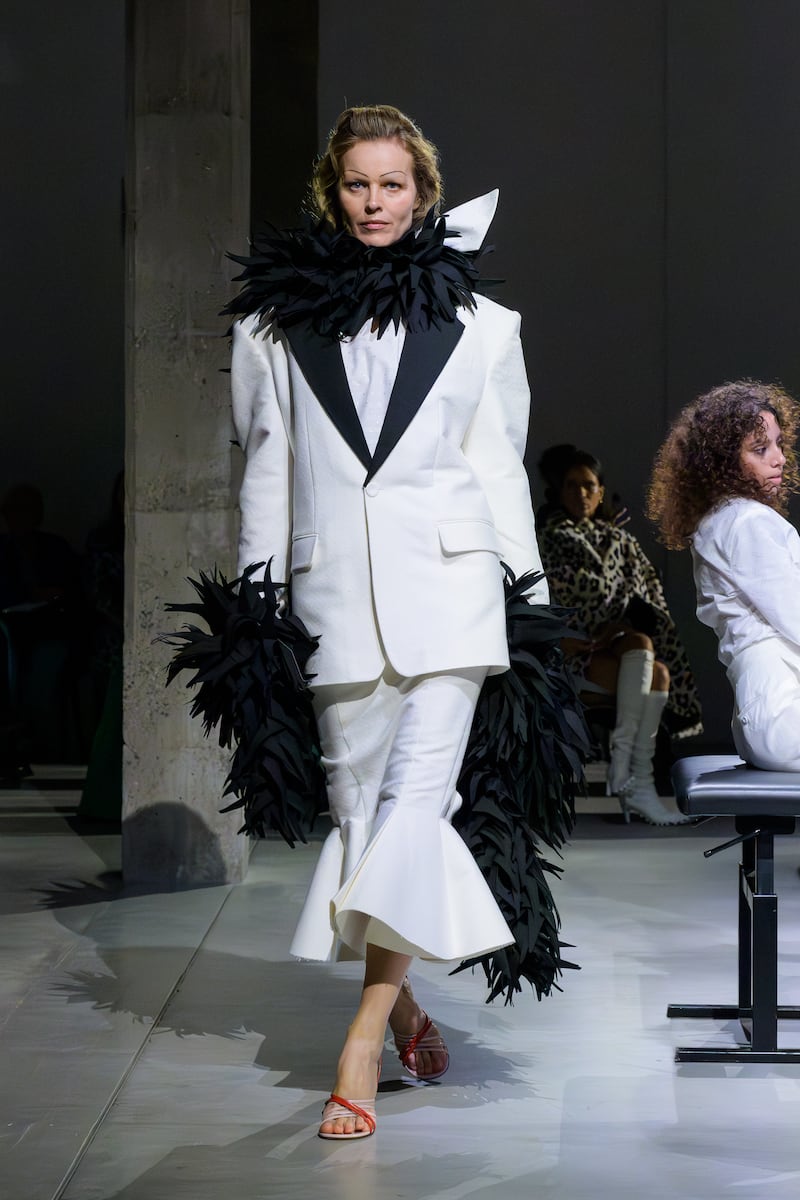
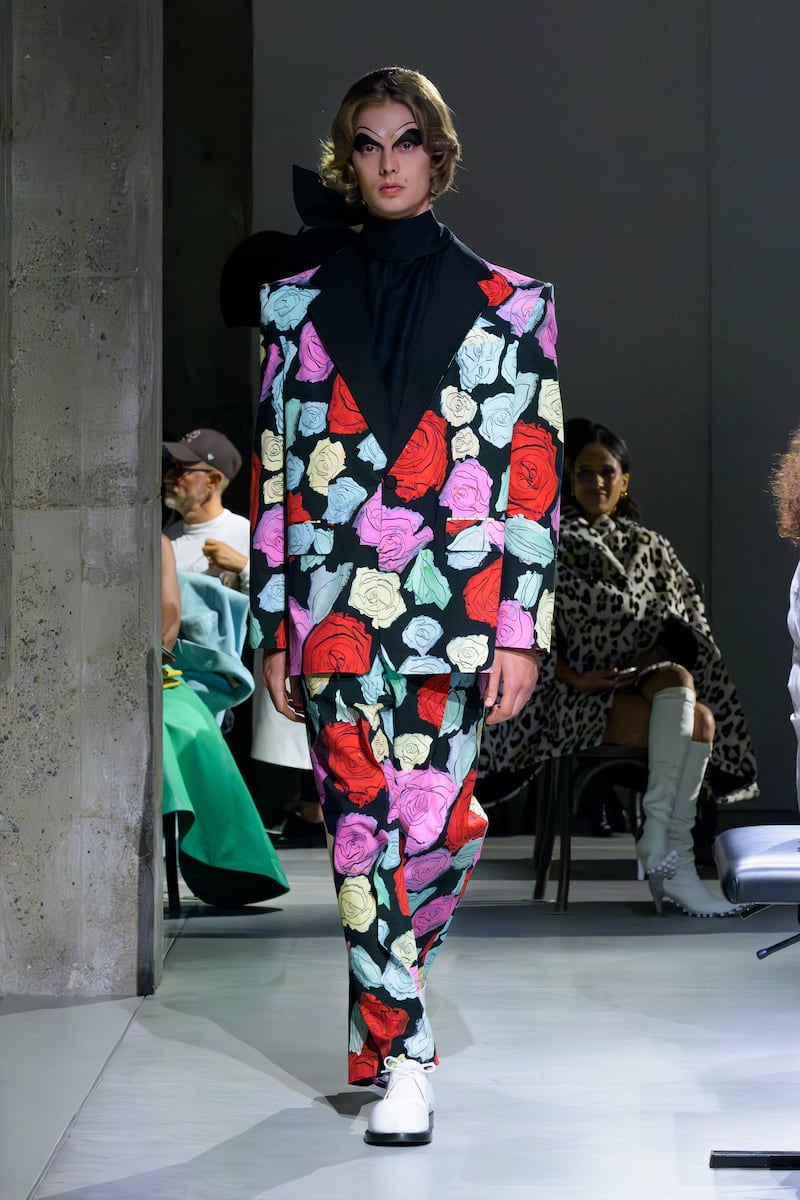
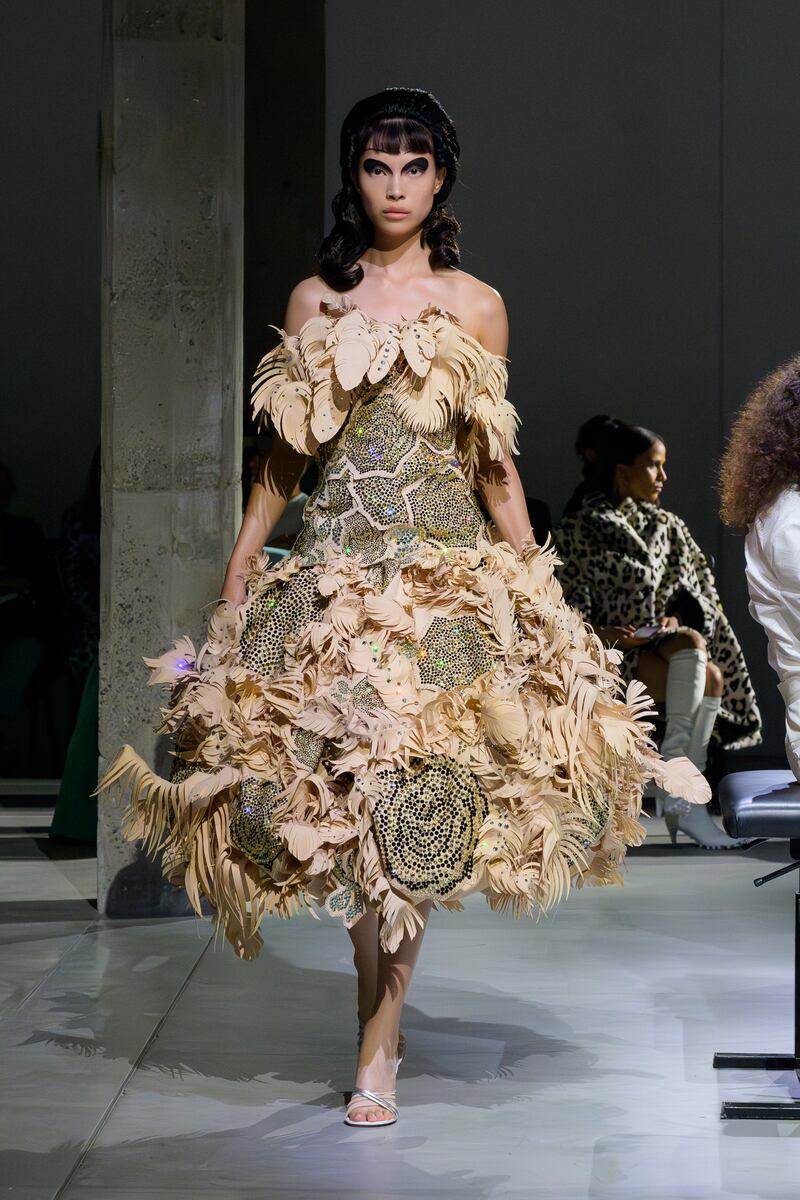
He saw cotton thread as a great connector, analogous to the thread of a conversation, the glue of a relationship, or even the way the models were about to thread round their way around the seating arrangement. Risso has never had any difficulty overlaying his own quirky vision on the quotidian mess of reality. And that usually means there is a great sense of play in his Marni. He even fished out a Heraclitus quote from the 5th century BC to back himself up: “Man is mostly nearly himself when he achieves the seriousness of a child at play.” (I looked it up to get the words exactly right.) The cast was wearing pleated bucket hats which looked piratical. That sort of fitted with the lawlessness of Léon. There were other exaggerated, almost cartoon-y details, like the giant “feather” boa that wrapped Malick Bodian, or the makeup for both men and women which emphasised arched thinly pencilled brows and made Eva Herzigova look like a silent movie star, and the other Leon, the Dame of catwalk fame, look like Divine as Babs Johnson in Pink Flamingos. His broad-shouldered suit was a lush floral spectacle. John Waters would have thrilled to it.
Risso is fearless in the way he grabs an idea and squeezes and colours and reshapes it until it is simultaneously as playful and serious as the child Heraclitus was watching thousands of years ago. He’s fashion’s most gleeful brainiac, and it’s reassuring that his idiosyncratic idea of what makes something beautiful is striking such a chord around the world.
I felt an oddly similar sensation while I was watching the Jil Sander show on Tuesday, how intelligence and idiosyncrasy can combine to create something that is visually alluring on a higher plane and sensually irresistible on a gut level. There was a gorgeously sinister sleekness at work in Lucie and Luke Meier’s latest exercise. It felt necessary after last season took the Meiers’ experiments with cerebral volume to an extraterrestrial limit. This collection was firmly rooted on dark, possibly dangerous terra firma. “Well, obviously we’re living in a dark world,” said Lucie. “So let’s say we were attracted by darkness, and we like the ambience when it changes from light to dark.” That was instantly obvious in the fabrics. The first few looks featured the tonal shifts of tonic, a fabric which will always speak to the mod 60s in my book. Then there was shimmering charmeuse, and shiny, shiny leather, with hair lacquered to match (kiss curls for the bad boys). A baggy black suit meant business, but its lingerie pink shirt and skinny tie said purest fetish.
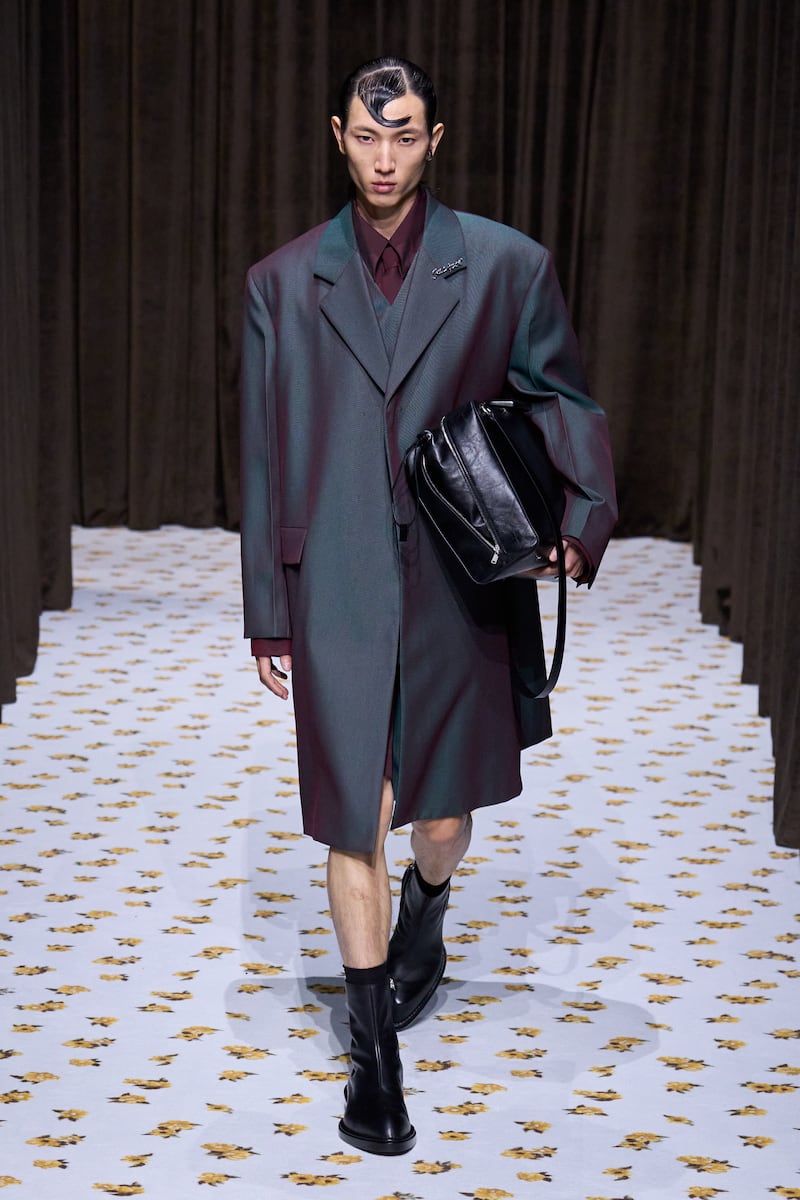
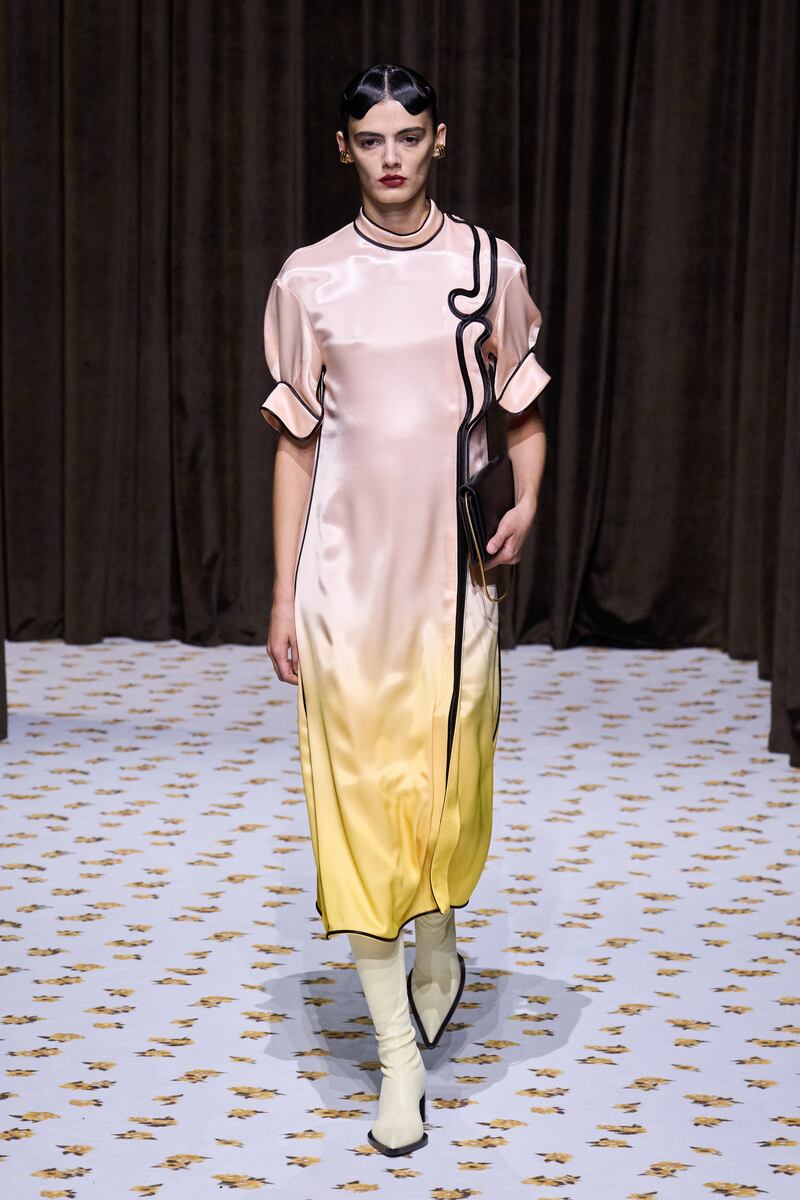
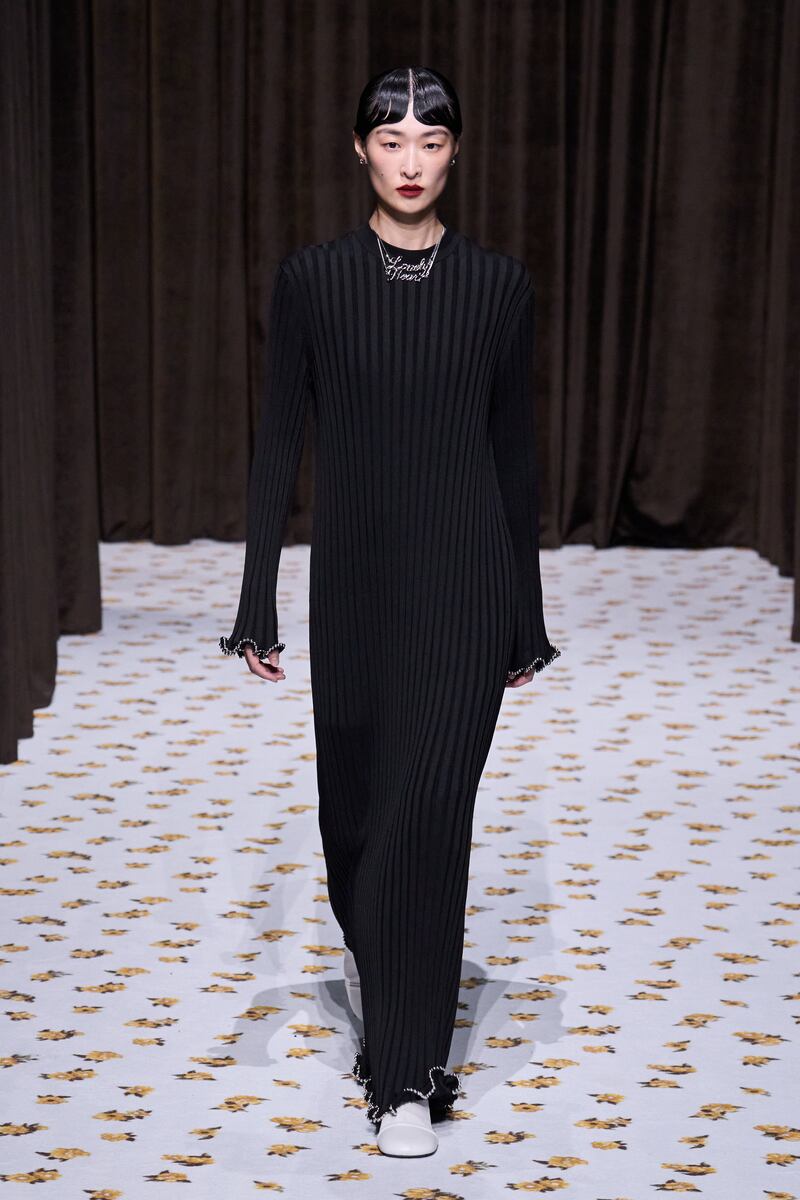
The set featured a floral-patterned carpet and huge curtains defining the space. I thought the whole scenario was David Lynch, Blue Velvet, Twin Peaks with a hit of Mulholland Drive but Luke said no. He grew up in Vancouver, where he was very taken by the work of photographer Greg Girard, another Vancouverite, whose pictures of changing Asian cities inspired the palette and the graphics of the new collection. A Girard photo of a car parked under a street light was printed on a shirt and skirt. It was particularly, irresistibly lurid.
But the show’s dark magic was also romantic (the Meiers do romance well). Maybe the Asian influence in a cheongsam-like dress or a pair of silk pyjamas or a slender ribbed knit ending in a ruff of pearls or a cluster of bright flowers painted on shiny black patent leather could be traced back to a Girard photo, but they made me think more of “In the Mood for Love,” the Wong Kar-Wai movie that was a huge fashion influence at the turn of the century. Bryan Ferry was on the soundtrack then, here it was Johnny Jewel producing the Chromatics, and, in Benji B’s mix for the show, it was just one more major plus.

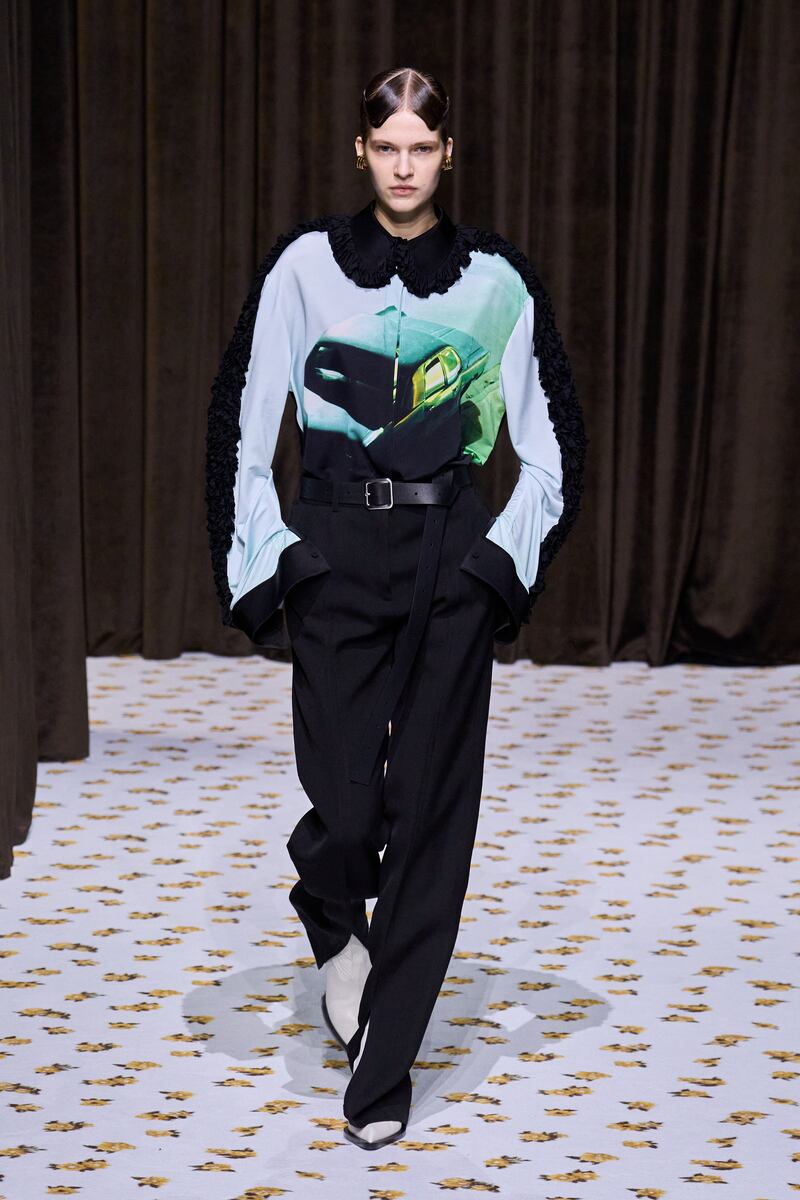
The Meiers went harder, and it totally worked. But we started with gossip, so there’s a circular logic in ending with more, and the rumour that says the couple aren’t long for the world of Jil Sander. After that presentation, it would seem like sheer lunacy to release them into the wild. On the other hand, if what they made was created in a spirit of defiance, then all power to them and their glittering future.

